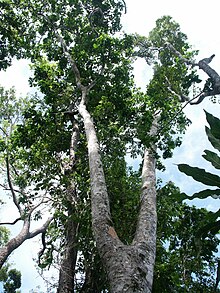| Intsia bijuga | |
|---|---|

| |
|
Scientific classification
| |
| Kingdom: | Plantae |
| Clade: | Tracheophytes |
| Clade: | Angiosperms |
| Clade: | Eudicots |
| Clade: | Rosids |
| Order: | Fabales |
| Family: | Fabaceae |
| Genus: | Intsia |
| Species: | I. bijuga
|
| Binomial name | |
| Intsia bijuga | |
| Synonyms [2] | |
| |
Intsia bijuga, commonly known as Borneo teak, Johnstone River teak, Kwila, Moluccan ironwood, Pacific teak, scrub mahogany and vesi, [3] [4] [5] is a species of flowering tree in the family Fabaceae, native to the Indo-Pacific. It ranges from Tanzania and Madagascar east through India and Queensland, Australia, Papua New Guinea to the Pacific islands of Fiji and Samoa. [3] [4] [6] It grows to around 50 metres (160 feet) tall with a highly buttressed trunk. It inhabits mangrove forests. Intsia bijuga differ from Intsia palembanica in the number of leaflets that make up their compound leaves. [7]
The tree has a variety of common names including ipil and kwila. [8]
Uses
This section needs additional citations for
verification. (February 2024) |
The bark and leaves of the ipil are used in traditional medicines. The tree's timber, called kwila (taal in the Philippines, merbau in Australia, vengai in Tamil Nadu and South India), is a very durable and termite-resistant wood, making it a highly valued material for flooring and other uses. The wood can also be used to extract a dye. The tree can contain a "gold" fleck that runs through the grain, considered to be attractive by some. Due to extensive logging of the tree, it is endangered in many places in Southeast Asia, and almost extinct in some. [9] Extensive amounts were purchased for the venue of the 2008 Summer Olympics in China, which is the largest importer of the wood. [10] The wood is used for flooring in U.S. and European markets where it is commonly sold under different names. Both licensed and unlicensed mills harvest the wood.
Illegal logging
According to Greenpeace large amounts of ipil timber sourced from illegal logging is being imported into China where there are lax import rules. Greenpeace are targeting users in Western countries in order to halt the trade in ipil wood. Greenpeace claims that at the current rate of logging the tree will be wiped out within 35 years. [10]
In New Zealand, where the ipil wood is known as kwila, attempts have been made to stop it from being imported. In 2008 retailers were divided in whether the sale of kwila should be banned. Jim Anderton, who was the Minister in charge of the Ministry of Agriculture and Forestry at that time, did not support a ban and instead he left it up to consumer choice. [11]
Symbolism
Intsia bijuga, locally known as ifit, is the official tree of the United States territory of Guam. No longer abundant since World War II, it is illegal on Guam to cut live ifit trees. It remains the most popular wood for local carvers. [12]
References
- ^ Barstow, M. (2020). "Intsia bijuga". IUCN Red List of Threatened Species. 2020: e.T32310A2813445. doi: 10.2305/IUCN.UK.2020-3.RLTS.T32310A2813445.en. Retrieved 19 November 2021.
- ^ a b "Intsia bijuga". International Legume Database & Information Service. Retrieved 2016-11-15 – via The Plant List. Note that this website has been superseded by World Flora Online
- ^ a b F.A. Zich; B.P.M Hyland; T. Whiffen; R.A. Kerrigan (2020). "Intsia bijuga". Australian Tropical Rainforest Plants, Edition 8. Commonwealth Scientific and Industrial Research Organisation (CSIRO). Retrieved 7 April 2021.
- ^ a b "Intsia bijuga". Germplasm Resources Information Network. Agricultural Research Service, United States Department of Agriculture. Retrieved 7 April 2021.
- ^ "Intsia bijuga (vesi)" (PDF). Agroforestry.org. Retrieved 7 April 2021.
- ^ "PNGTreesKey - Intsia bijuga Kuntze". www.pngplants.org. Retrieved 2021-02-12.
-
^
Tropical Legumes: Resources for the Future : Report of an Ad Hoc Panel of the Advisory Committee on Technology Innovation, Board on Science and Technology for International Development, Commission on International Relations, National Research Council. National Academies. 1979. p.
216. NAP:14318.
Intsia bijuga and Intsia palembanica differ mainly in the number of leaflets that make up their compound leaves. Both are native to tropical rainforests in Southeast Asia and the islands of the southwest Pacific.
- ^ "Tree Conservation Information Service". UNEP-WCMC. 2007-09-05. Archived from the original on 2007-01-15. Retrieved 2008-08-23.
- ^ Wild Singapore
- ^ a b Bristow, Michael (2007-07-06). "China trade threatens tropical trees". BBC.
- ^ Gibson, Eloise (18 August 2008). "Stores divided over calls to ban kwila". New Zealand Herald. Retrieved 26 June 2010.
- ^ Wescom, Robert W. (March 19, 2021). "Guam Trees: Ifit". Guampedia. Retrieved 6 April 2021.
Further reading
- F.A. Zich; B.P.M Hyland; T. Whiffen; R.A. Kerrigan (2020). "Intsia bijuga". Australian Tropical Rainforest Plants, Edition 8. Commonwealth Scientific and Industrial Research Organisation (CSIRO). Retrieved 5 March 2021.
- Sze Pang Cheung; Tiy Chung; Tamara Stark (17 April 2007). "Merbau's Last Stand" (PDF). Greenpeace International, Amsterdam.
- Sihite, Jamartin (August 2005). Bintuni Bay Nature Reserve Management Plan - Irian Jaya Barat Province 2006-2030 (PDF). The Nature Conservancy. ISBN 978-979-97700-3-5. Archived from the original (PDF) on 2011-09-30. Retrieved 2007-03-22.
External links
-
 Media related to
Intsia bijuga at Wikimedia Commons
Media related to
Intsia bijuga at Wikimedia Commons -
 Data related to
Intsia bijuga at Wikispecies
Data related to
Intsia bijuga at Wikispecies - CIRAD Forestry Department — timber data
